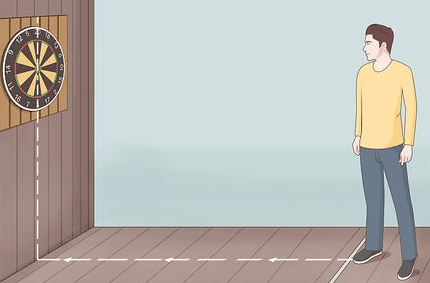Building consistency in darts throwing can elevate your performance and lead to steady improvement over time. While each player has a unique style, mastering certain foundational aspects can create a solid base for refining skills. Having a darts throwing routine is one of the main foundational skills.
Developing a reliable routine involves perfecting body mechanics, establishing a mental routine, practicing regularly, and tracking progress.
1. Understanding the Importance of Consistency
A consistent throwing routine is essential because it minimizes variables that might impact your performance. By refining your routine, you’ll establish muscle memory, which is vital for accuracy. Even on days when you may not feel at your best, having a solid routine in place can help you achieve steady results.
2. Positioning Yourself at the Oche (Throwing Line)
Your stance at the oche, or the line you throw from, is the foundation of your routine. Here are key tips to establish consistency in your stance:
- Foot Placement: Decide whether you prefer a closed (dominant foot forward) or open stance (both feet angled). Many players find a slight angle comfortable.
- Weight Distribution: Position your weight slightly on the front foot, as this helps with balance and control.
- Shoulder and Hip Alignment: Keep your shoulders relaxed, aligning your throwing shoulder directly toward the dartboard. This alignment reduces unwanted lateral movement.
3. Mastering Your Grip
The grip is one of the most personal aspects of dart throwing, yet a consistent grip is critical for control:
- Choose Your Finger Placement: Most players find a three-finger grip comfortable—thumb, index, and middle finger on the dart shaft.
- Avoid Over-Gripping: A firm but relaxed grip allows better control and smooth release.
- Maintain a Consistent Hold: Avoid adjusting your grip during a match. Practice holding your dart the same way every time.

4. Developing a Steady Aim
Aiming consistently is crucial for hitting desired areas on the board. Here are steps to refine your aim:
- Focus on a Specific Target: Instead of just the general area, choose a specific point within your target zone.
- Use Your Dominant Eye: Close one eye and adjust your stance to find the natural line of your dominant eye. This will ensure more accuracy.
- Maintain Eye-Target Connection: As you bring your dart back, keep your eyes locked on your target.
5. Perfecting Your Throwing Motion
A smooth, repeatable throwing motion leads to greater consistency. Here’s how to practice:
- Start with a Fluid Back-and-Forth Motion: Bring your arm back slowly, then smoothly move forward without hesitation.
- Release at the Same Point Each Time: To ensure consistent trajectories, practice releasing the dart at the same angle and position relative to your body.
- Follow Through: After the dart leaves your hand, let your arm continue naturally in the direction of the throw. This reinforces your aim.
6. Setting a Mental Pre-Shot Routine
A pre-shot routine helps keep nerves under control and maintains focus:
- Visualize the Throw: Picture the dart landing in your target spot before throwing. This visualization helps reinforce confidence.
- Take a Deep Breath: Pausing to breathe deeply can lower heart rate and improve focus.
- Use a Self-Talk Cue: A short word or phrase can mentally anchor you, such as “steady” or “smooth.” Use it to remind yourself of your objective.
7. Establishing a Warm-Up Routine
A warm-up is essential to loosen muscles and prepare mentally:
- Begin with Arm and Shoulder Stretches: Gently stretch your shoulder, wrist, and fingers.
- Throw Low-Pressure Practice Rounds: Start with a few low-stakes throws. Aim for high-scoring sections to warm up your aim.
- Move to Targeted Practice: Transition to aiming at doubles, trebles, or specific areas to refine precision.

8. Practicing Routine Drills to Reinforce Consistency
Incorporate regular drills into your practice sessions:
- Around-the-World Drill: Hit each number on the dartboard in succession. This improves accuracy and muscle memory for targeting specific areas.
- Doubles and Trebles Practice: Spend time on the outer rings of the board to build precision, especially for endgame throws.
- Scoring Routines: Practice 501 or 301 to simulate real-game pressure. Keep track of your score with each practice to monitor progress.
9. Building a Habitual Practice Schedule
Creating a regular practice schedule helps lock in muscle memory and improve over time:
- Set a Weekly Goal: Aim for a specific number of practice sessions each week.
- Divide Practice into Segments: Dedicate time to each aspect of your routine—warm-up, drills, and full games.
- Consistency Over Duration: Short, regular practice sessions are more effective than sporadic, lengthy sessions.
10. Tracking Your Progress
Keeping a record of your practice can give you insights into areas that need improvement and help maintain motivation:
- Use a Darts Journal: Track scores, hit percentages for doubles, trebles, and areas you struggle with.
- Set Achievable Milestones: For instance, increasing accuracy by a certain percentage in a month.
- Celebrate Small Wins: Recognize improvements to stay motivated.
Darts Throwing Routine conclusion
Developing a consistent darts throwing routine is the cornerstone of improvement. By building reliable mechanics, incorporating drills, and setting mental anchors, you’ll achieve better scores and more enjoyable gameplay. With patience, persistence, and dedication, your routine will not only lead to greater consistency but will also allow you to excel under the pressures of competition.




